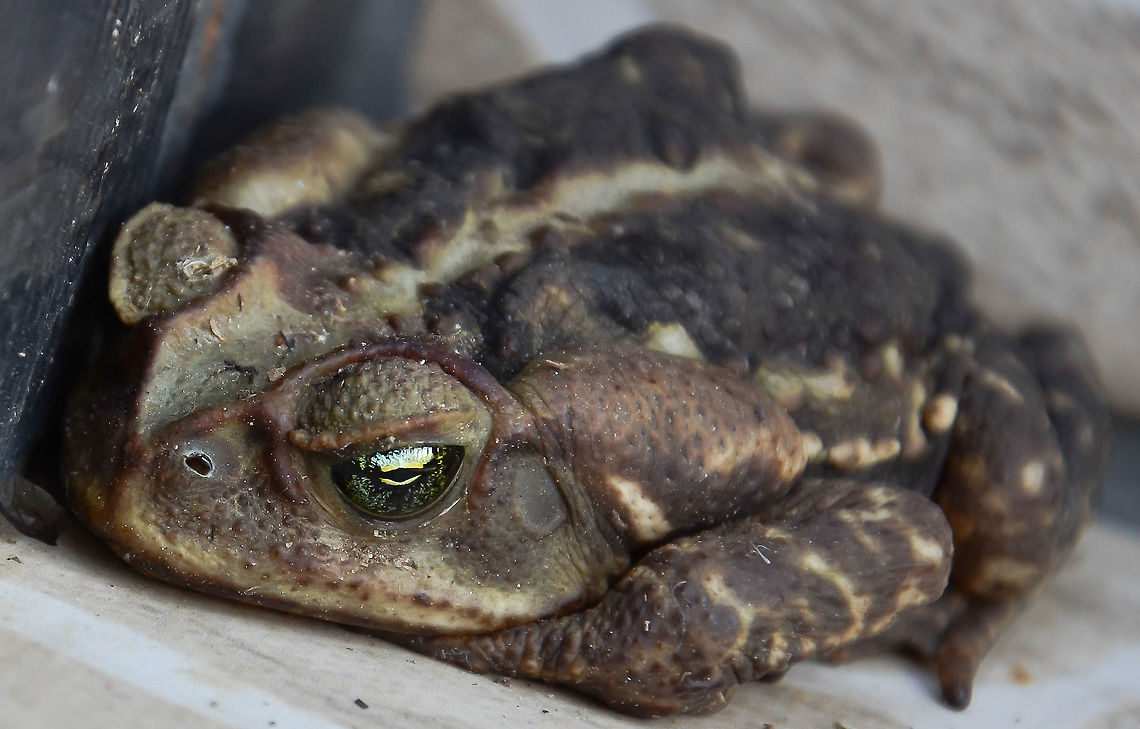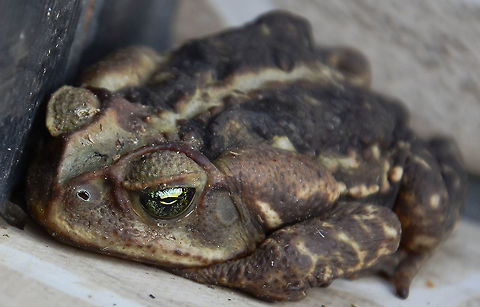 PromotedSpecies introCountry intro
PromotedSpecies introCountry intro
Rhinella icterica - Sapo-Cururu / Yellow Cururu Toad (Spix, 1824)
Amphibia: Lissamphibia: Batrachia: Anura: Neobatrachia: Bufonoidea (Hyloidea???): Bufonidae
The name "cururu" is an indigenous name that refers to the sound of the mating call of the males. They belong in the class Amphibia, subclass Lissamphibia, superorder Batrachia, order Anura suborder Neobatrachia, superfamily Bufonoidea (Hyloidea???) and family Bufonidae. The subject portrayed is a female.
They are native to Northeastern Argentina (Misiones Province), Southern Brazil and Eastern Paraguay. The males usually measure around 98-166mm in length and females 110-190mm in length. Young females possess a yellow dorsum with a light midline stripe and a patterns of black markings. Males are usually of a bright greenish yellow coloring with very few black markings. They possess a white belly marbled with brown and strong cephalic crests with warted skin.
They inhabit Cerrado (savanna), tropical and subtropical forests, and pastoral plains covered in fields located on the South of South America. They can live in degraded habitats and fields. They are usually found in anthropic areas in urban and suburban habitats due to the abundance of food sources (insects attracted to the artificial lights).
Their parotoidal glands are strong and ooze bufotoxins, which composition varies among the species and are toxic steroid lactones. These toxins can be divided into two groups, which are bufadienolides (cardiac glycosides such as bufotalin and bufogenin) and tryptamine (related substances such as bufotenin). The substance sprays out of the gland when the toad is squished or disturbed, but the human cases of intoxication are very rare and treatment involves gastric decontamination and management of arrhythmias. Digoxin antidotes might have to be used.
This defensive mechanism coupled with their successful reproductory history has led them to propagate with ease. Predators tend to avoid them due to the toxin; snakes are usually killed by the strong toxin when ingesting them. Their life cycle goes from the laying of eggs, to the hatching of the tadpoles, turning into an imago and proceeding to grow into the adult. They are very ecologically important as natural biological controllers of Insects, Mollusks, small rats and many Arthropods. They are also known to prey on birds and their eggs, as can be seen in a source I provided at the end of this text. The tadpoles feed on suspended matter and on the surface of rocks and submerged plants.
The reproductive season starts from August to January in rivers and in collections of still waters such as lagoons and ponds. The males mainly vocalize during the night to call females, but can also do so during the day. In the reproductive season, the mating calls are usually vocalized near water sources. The eggs are laid in a gooey string, usually in several thousands. The tadpoles tend to stay together.
The egg string is large and are deposited at shallow water. Amphibian decline in populations can be due to general habitat alteration and loss, habitat modification from deforestation, or logging related activities and local pesticides, fertilizers and pollutants. Rhinella icterica is not endangered, although in some places they are suffering populational decline due to pollution and due to the draining of their water sources. They are also ignorantly killed by people.
You can hear their call here: https://amphibiaweb.org/sounds/Rhinella_icterica.mp3
PERSONAL NOTE: I handled many of these toads, including the one portrayed to keep the dogs from eating them. After the rescue, she was placed on these steps away from danger where she fell asleep. She thought I was a predator or a threat and sprayed the bufotoxin on my skin and absolutely nothing happened, which makes me believe the bufotoxin can only be absorbed by a few parts of the body such as the mucosa, open wounds and through ingestion. I've handled Rhinella icterica many times, and few were the attempts that the toad didn't spray the toxin. The spraying is not far, usually very limited and in my attempts just oozed and dripped from my hand. I never suffered any harm from handling them, even when I had semi-open wounds on the skin and the toxin was sprayed on them, perhaps not enough to enter them. This makes me think this toxin is potentially dangerous to the ingestion, absorption through the mucosa or an unfortunate event of absorption through an open wound. With this I conclude that the toxin is not dangerous to the contact with a healthy skin.
Sources:
https://amphibiaweb.org/species/200
http://br.herpeto.org/anfibios/anura/rhinella-icterica/
https://pt.wikipedia.org/wiki/Rhinella_icterica
https://en.wikipedia.org/wiki/Rhinella_icterica
Bird and egg predation by Rhinella icterica: https://www.researchgate.net/publication/263469197_Ornithophagy_in_Rhinella_icterica_SPIX_1824
Date: 27th of September, 2017 at 05:21:46pm.

''Rhinella icterica'' is a species of toad in the family Bufonidae that is found in northeastern Argentina , southern Brazil, and eastern Paraguay. "Cururu" is its indigenous name and refers to the male advertisement call that is a melodious tremolo.

comments (1)